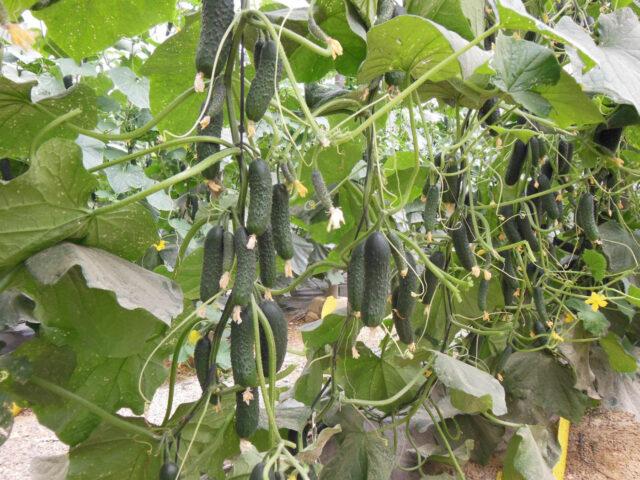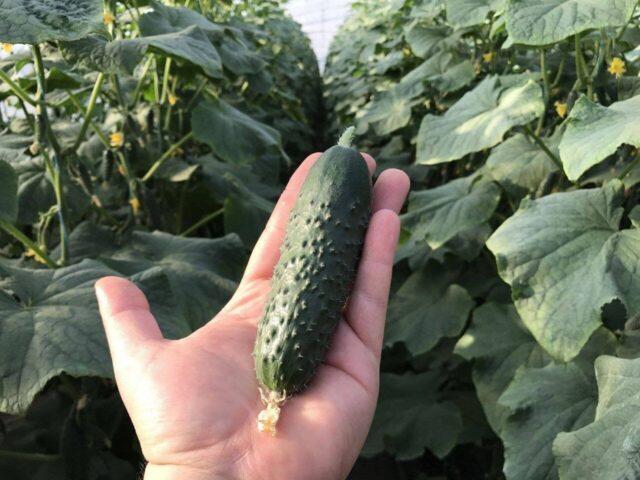Content
Cucumber Severin is a versatile hybrid that has a number of unique properties. The variety has earned the love and trust of many gardeners due to its ability to bring an excellent harvest for a long time. The variety is very hardy, even bad weather conditions and the length of daylight do not affect the abundance of fruiting and the quality of the fruits.

Cucumber Severin F1 is an ultra-early ripening variety that bears fruit immediately and abundantly
Breeding history
The hybrid was obtained thanks to the work of Dutch scientists from the Enza Zaden company. The Severin variety is new, self-pollinated, parthenocarpic. In Russia, he successfully passed tests from the Central Black Earth zone to the lands of the North Caucasus.
Description of cucumbers Severin F1
The plant forms medium-sized bushes with a powerful central stem, forms small shortened lateral shoots. The leaves of the variety are regular, large, dark green in color. In each node, the Severin cucumber forms three female flowers and 2-3 fruits in one bosom. Fruits are cylindrical, lumpy, green in color without light stripes. Length from 10 to 13 cm, size 3-4 cm in diameter, weight up to 150 g. The taste of Severin cucumber is excellent, the pulp is fragrant, crispy and juicy. Fruits are firm and firm, with small seeds inside.
Characteristics of the variety
Cucumber Severin is intended for cultivation in regions with different climates. Due to its long-term retention of presentation and the ability to carry transportation over long distances, the variety is ideal for commercial cultivation. The fruits are universal in use, suitable for fresh consumption, pickling and salting for the winter. When preserved, crispy, firm, without voids.
It is recommended to grow Severin cucumber in the first and second revolutions in film greenhouses, as well as in the open field. The variety forms an ovary well and does not shed it even in bad weather conditions. Crop care is not laborious, harvesting is easy.

Severin cucumber has no bitterness at the genetic level
Yield
The crop is characterized by good regeneration and high yields. Bears fruit for a long time, up to frost. For one collection, up to 17 pieces are removed from each bush. It is noteworthy that the fruits of the Severin variety cucumber have limited growth, which is very convenient for gardeners who do not have the opportunity to harvest regularly.
Ripening and flowering terms
A vegetable crop blooms about 25-30 days after planting, but depending on the region and growing conditions, the period may differ slightly. By ripeness, the Severin cucumber belongs to the early species. The first crop is harvested after a month and a half after germination. Collecting is done every two days, but even if it is not carried out on time, the greens will not turn yellow. The harvested fruits have a long shelf life. They can stay in the refrigerator without damage for up to 14 days.
Disease and pest resistance
The Severin cucumber is quite resistant to diseases and insects, with a stable yield even under stressful conditions. It is practically not susceptible to mosaic, powdery mildew and cladosporium disease. But due to high humidity, it can get sick with late blight, sometimes it suffers from a black flea and a spider mite.
Advantages and disadvantages
The Severin F1 hybrid has a large number of advantages, according to many gardeners it is considered one of the best varieties of cucumbers.

The Severin variety is mainly planted in greenhouses using standard agricultural technology.
Advantages:
- early ripening;
- excellent taste;
- high productivity;
- disease resistance;
- almost year-round cultivation;
- resistance to insufficient lighting;
- good keeping quality and transportability;
- universal use.
Significant disadvantages of this variety have not yet been found. But according to some gardeners, the cost of Severin cucumber seeds is slightly higher than that of other varieties.
Planting cucumbers Severin
The hybrid can be planted almost all year round. Since the Severin variety of cucumber has increased cold resistance and is undemanding to climatic conditions, it can be grown both in the spring-summer period and in the autumn-winter period. Planting dates vary from January 25 to September 15. Due to the fact that the variety, in particular, grows in greenhouses, it is recommended to organize a warm bed for it:
- Dig up the soil in the greenhouse.
- Form high beds, in the middle of which dig furrows on two bayonets of a shovel.
- Cover the grooves with hay or straw (30 cm), cover with manure (20 cm), sprinkle with dolomite flour, tamp, bury with soil.
Important! Additionally, it is recommended to fertilize the soil with wood ash, superphosphates and potassium sulfate at the rate of 50, 150 and 50 g per square meter, respectively.

A warm bed will warm up the plants from the inside and will certainly prevent them from freezing when the temperature drops sharply.
A few days before planting, so that the Severin cucumber is not attacked by pests, it is recommended to shed the soil with Apache or Aktar preparations. When planting planting material, it is advisable to add 20 g of Fertik, 30 g of Borofoski or Kalimaga to each hole.
Sowing in open ground
Some gardeners sow Severin cucumber seeds in open ground. This factor does not affect the yield and taste of the vegetable, but the disadvantage of this method may be poor germination. In order to carry out planting work, you should wait until the ground warms up to at least +15 ° С, preferably up to + 18-20 0C. Then prepare the bed: dig up, fertilize, moisten. Lower the seeds of the variety 2 cm deep, maintaining an interval of 10 cm between them, water again. It is advisable to sprinkle a nutritious soil mixture over the garden bed.
Seedling method
Severin cucumber seeds are recommended to be planted for seedlings in individual containers in order to do without picking. Sowing is done in moistened soil purchased in a specialized store. The planting material is laid out on its surface, sprinkled with earth with a layer of 1 cm, lightly sprinkled with water, covered with foil. The containers are installed in a dark room with a temperature of +26 ° C, a week later, when shoots begin to appear, the cups are transferred to a lighted windowsill, and the temperature is lowered to +22 0C. When 3-4 leaves appear on the seedlings, it must be planted in a permanent place. Cucumber Severin is planted in warm beds of a greenhouse according to the following scheme:
- dig holes 6-8 cm deep;
- pour them with warm water;
- placed in the wells of the plant along with a lump of earth;
- fall asleep with soil, tamp;
- watered abundantly.
A distance of 30 cm is maintained between Severin cucumber seedlings, 80 cm between rows.
Severin cucumber care rules
According to the originator of the variety, the culture is unpretentious to growing conditions and requires only basic agrotechnical work. Severin cucumber care measures are standard:
- Watering. This plant variety needs regular but moderate moisture.On hot days, planting is watered every 2-3 days, in cool weather 1-2 times a week. Only warm water is used for humidification.
- Top dressing. To get a good harvest of Severin cucumbers, they are fed a couple of times per season. For this, minerals and organics are used. The first time feeding is carried out at the stage of peduncle formation, for this, 10 g of potassium chloride and ammonium nitrate, superphosphate (20 g) are diluted in a bucket of water. A liter of solution is poured under one plant. The second feeding is carried out when green plants begin to form on the bushes. They use complex fertilizers containing phosphorus, potassium, nitrogen.
- Hilling. To protect the roots of the plant from pests and drying out, the beds with cucumbers should be spud up in time. After irrigation, the earth is raked up, forming a ridge of five centimeters in height.
- Garter. Severin cucumber does not have a high climbing ability, but curly stems should still be tied to supports. This greatly facilitates harvesting, besides, the fruits in this case will always be clean.

The Severin variety forms an average number of stepchildren
Conclusion
Cucumber Severin is a new variety of vegetable crops that has successfully established itself among gardeners. It has many advantages, it can be successfully grown in greenhouses and in the open field. The variety does not require special attention to itself, grows well and develops even in unfavorable conditions. The fruits have a beautiful appearance, they are even, medium-sized, ideal for preparing blanks for the winter.
Reviews of gardeners about cucumbers Severin F1








